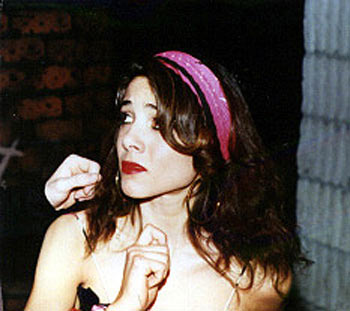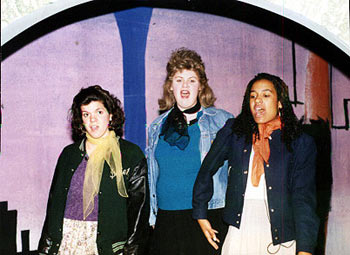HFC Presents: Little Shop Of Horrors
Production Information
Written by: Howard Ashman
Music By: Alan Menken
Directed by: Dr. George Popovich
Little Shop of Horrors has its origins in science-fiction films of the fifties, with some borrowing from classic fantasy films such as King Kong (1933) and classic horror films such as Frankenstein (1931). A noticeable development of the fifties cinema was the emergence of several types of science-fiction films that influenced the plot of Little Shop of Horrors. Foremost of those forms is the "invader from space" film. Some critics believe that film motif was influenced by the "Red Scare" of the McCarthy years. Examples of such films are The Thing (1951), Earth vs. The Flying Saucers (1956), The Blob (1958), and Invasion of the Body Snatchers (1956). The basic plots of those films center around "invaders from space" that threaten mankind in one form or another. Sometimes the invasion is in the form of alien military strength as in War of the Worlds (1953). Other times it is in the form of a takeover of human minds in such films as Invasion of the Body Snatchers.
Another film variety that surfaced in the fifties was the creature film. Usually the creature was a product of nuclear radiation; a mutation created by atomic bomb testing that came back to "wreak havoc on mankind." One of the most famous of those films is Godzilla. We refer here to the first film featuring the monster Godzilla, relased in America in the mid-fifties. Originally the creature was a destructive, threatening force and not the children's hero of later films and cartoons. The original Godzilla was a hulking beast that trampled Tokyo and threatened the world. The original plot of Godzilla posits that the creature was unleashed from the earth by the United States' use of the atomic bomb during World War II.
Another concept generic to horror films and some science-fiction films is that of the Faust legend. Essentially a feature of Greek and Elizabethan drama, the Faust motif involves a human being who steps above the "laws of God and man." The original Faust sold his soul to the devil in order to gain wealth and power. The most famous example of the Faust motif in horror films is the mad scientist who "tampers with nature." Although they are not the raving, melodramatic characters of earlier films the mad scientist still appears in today's horror and science fiction films such as the remake of The Fly (1986) and Altered States (1980). In Little Shop of Horrors, Seymour is the Faust character.
It should be noted that the fifties films were made in earnest. The creatures were meant to be frightening, the threats real. By today's standards, most of these films emerge as overly melodramatic and the special effects laughable.
The 1961, low-budget film Little Shop of Horrors is still known today because it is Jack Nicholson's first film. The film is an original for its time, mainly for its irreverence for the science -fiction films upon which it was based. The film abounds with camp and black humor. Rather than taking itself too seriously, the film has a tongue in cheek attitude towards itself.
The musical version of Little Shop of Horrors is essentially a parody of certain types of science-fiction and horror "B" films. It has a charm all of its own. Little Shop's characters such as Audrey and Seymour have a naive innocence about them rather than an inbred self -conscious campiness. Audrey posses more of the innocence of Fay Wray in the original King Kong rather than the moxie of Jessica Lange in the remake of King Kong. Seymour, rather than a prat-falling nerd, is sincere in his affections toward Audrey and in his desire to better himself. The plant, described by the play's author as "rhythm and blues' answer to Richard III, " is a combination of people-killing Plants featured in such films as Day of the Triffids (1963) and intelligent aliens bent on world conquest in such films as Earth vs. The Flying Saucers, Kronos (1956) and Invaders from Mars(1953).
The musical version of Little Shop of Horrors is unusual in the fact that the evil plant is victorious. Most fifties science-fiction films showed human kind triumphant against the would-be invaders.
In our production, we have endeavored to bring you a taste of those old science-fiction and horror films. You will see posters from many of those films displayed before our performance in the form of slides. Those of you extremely familiar with those films might notice that the laser projection resembles images used in This Island Earth (1955) and Forbidden Plant (1956) and that the laser air effects resemble the ray effects used in War of the Worlds. And if you look closely, you will find other homages to a type of film that was born in an age of innocence.
Cast
- Chiffon: Renata Rhodes
- Crystal: Amy Armstrong
- Ronette: Heather Capote
- Seymour: Ron D. Kraai
- Audrey: Erick Milke
- Mushnik: Mark Powell
- Orin: Jeff Simms
- Audrey II Voice: Tom Downy
- Main Audrey II Operator: Tim Martin
- Audrey II Assistants: Suzanna Radwan, Lasonia Erving
- Customer: Shawn Balentine
- Wino, Bernstein, Patrick Martin: Adam Lux
- Bag Lady #1: Donna Montgomery
- Bag Lady #2, Mrs. Luce: Jennifer Sourbeck
- Cop: Dan Taylor
















